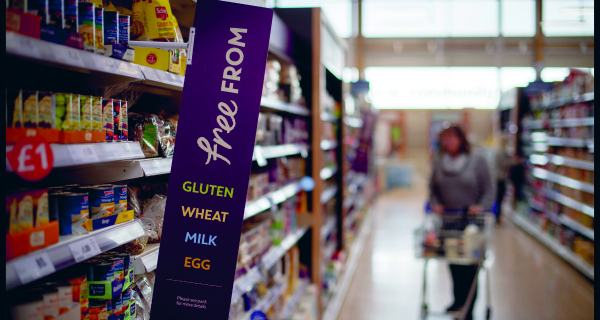
Free from is fast becoming a force to be reckoned with in UK grocery. Once a niche aisle tucked away in the back of supermarkets the category has grown 13% in 2016 to reach a whopping £531 million, up from an estimated £470 million in 2015, according to Mintel. This boost comes as more and more UK shoppers experiment with free from products, more frequently, with 48% telling Mintel they’ll shop in the free from aisle over the next 12 months, up from the third of Brits who say they’ve experimented with gluten free loaves or lactose free milk in the past six months.
FREE FROM AND ORGANIC GO MAINSTREAM – And what’s more Mintel expect sales to keep climbing, predicting sales across the market of £673m by 2020. The free-from market enjoyed remarkable growth in 2015, and further growth is likely to come from the existing pool of users intending to spend more, said Kiti Soininen, head of UK food, drink & foodservice research at Mintel. So what’s behind all this growth? How are retailers responding? And what opportunity is there for Italian suppliers? Whereas once consumers ditching meat for ethical reasons formed the backbone of many free from brands now it’s health that’s driving growth. For proof look no further than the exponential growth of gluten free foods. Sixty per cent of adults in the UK have picked up a gluten free product, according to YouGov, even though less than 1% are thought to suffer from coeliac disease. Labelled a fad by some critics it hasn’t stop the UK’s biggest grocer, Tesco, flagging up its gluten free festive goodies in the run up to last Christmas with gluten free stuffing and a retail first, free from profiteroles. The gap between free from foods and their standard equivalents is narrowing significantly, said Tesco food developer Fiona Carter. Customers no longer have to compromise on taste and quality because they’re on a free from diet. This trend is reflected in the list of our foods which are winning awards, like our strawberry and vanilla ice-cream cones. Our breaded Pollock actually won against mainstream products that do contain gluten, she added. It isn’t only retailers either, with major brands such as Pizza Express investing in gluten free versions of their bestselling SKU’s. In June the pizza brand launched a gluten free Margherita and dough balls into Sainsbury’s stores which it says it hopes to add to with a wider range of products available on supermarket stores in the near future. Meanwhile Morrisons has expanded its gluten free range to go beyond bread, cereals and flours and offer a wider range of cupboard essentials. But gluten isn’t the only frontrunner with sales of free from dairy alternatives also strong. The market is projected to grow globally to $19.5 billion in 2020 with 15.5% growth over the next four years, according to Markets and Markets, and retailers are looking to cash in. The most longed-for dishes for shoppers with allergens and intolerances are: pizza (82%), cheese board (77%), cheesecake (75%) and lasagne (73%).

HUGE POTENTIAL FOR ITALIAN FOOD – In fact, the popularity of Italian organic and free from products has spurned dedicated distributors such as ‘Free from Italy’ which works with Italian suppliers to secure UK stockists for their specialist goods. Their range includes the “award winning” La Buona Vita pasta which is now stocked at Morrisons and Ocado, and Le Conserve della Nonna Pasta Sauces created by the Fini Group. The opportunity for Italy is huge, believes marketing manager at free from pasta brand LDH La Doria Debbie Thomassen, whose products are stocked in Tesco. Italy’s culinary heritage creates the perfect conditions for Italian food companies to develop the world’s best glutenfree products, she said. Wheat is such a critical ingredient in Italian cooking that the Italian must solve the problem of gluten-free but tastes great, and our new pastas do this. A lot of free from products are a real taste compromise – just like in the early days of low fat yoghurts – so there’s huge potential as Italian companies devise truly tasty product alternatives.
